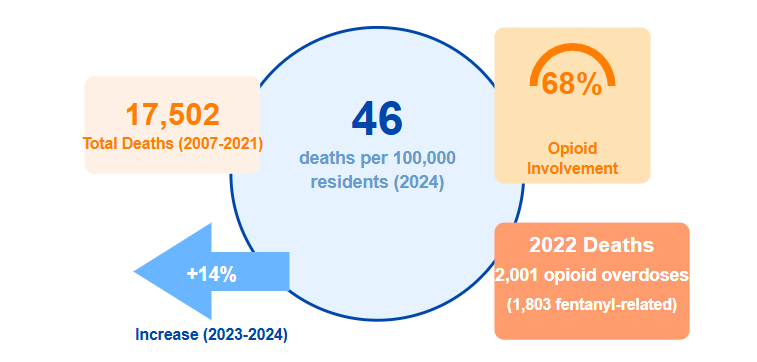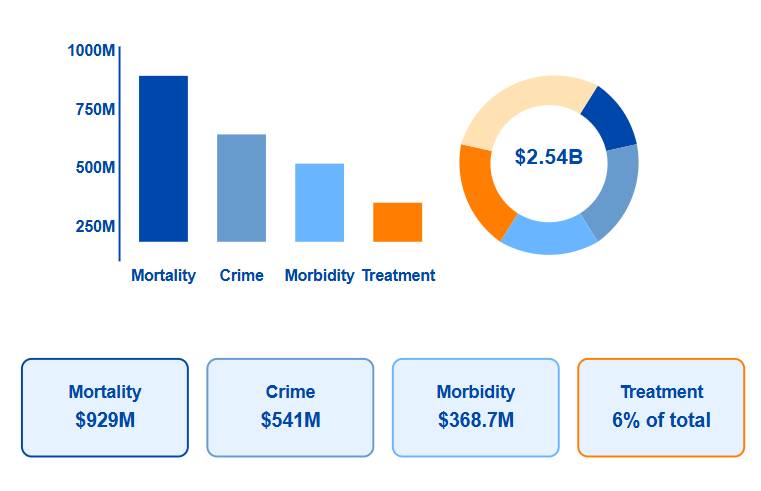Statistical Data on Drugs in Washington
Washington state faces significant substance abuse challenges, particularly with opioids, methamphetamine, and marijuana. Based on recent data, the state has experienced concerning trends in drug overdose deaths and substance use across different demographics.
Drug Overdose Statistics
- Annual overdose deaths (2024): 46 deaths per 100,000 residents
- Total overdose deaths (2007-2021): 17,502
- Opioid involvement: 68% of all overdose deaths
- Recent trend: 14% increase in overdose deaths between 2023-2024
- 2022 deaths: 2,001 opioid overdoses (1,803 fentanyl-related)

The state has seen a significant increase in overdose deaths, particularly from fentanyl, contrasting with national trends showing a 10% decrease.
Demographic Impact (2022-2023): Deaths per 100,000 by ethnicity
- American Indian/Alaska Native: 97.0
- Black: 45.8
- Asian: 3.5
There is a stark racial disparity in overdose deaths, with Native Americans experiencing more than twice the death rate of other groups.
Drug Use by Substance Type (2021-2022)
| Substance | Past Year Use Rate (Ages 12+) |
| Marijuana | 29.13% |
| Cocaine | 1.85% |
| Heroin | 0.41% |
| Hallucinogens | 3.71% |
| Methamphetamine | 1.25% |
| Prescription Pain Reliever Misuse | 2.83% |
Current Substance Use Rates (2021-2022): Illicit Drug Use (Past Month)
- 12+ years: 22.72%
- 12-17 years: 9.60%
- 18-25 years: 33.72%
- 26+ years: 22.59%
Young adults (18-25) show the highest rate of illicit drug use, significantly above other age groups.
Youth Drug Use Statistics
61,000 teens (12-17) report drug use in the past month.
Marijuana use among teens:
- 88.52% of drug users used marijuana
- 16.21% used marijuana in the past year
Other substance use (12-17):
- Cocaine: 0.55%
- Methamphetamine: 0.18%
- Heroin: 0.09%
- Pain reliever misuse: 2.55%
Washington teens show an overwhelming preference for marijuana (88.52% of users), while maintaining relatively low usage rates of more dangerous substances like cocaine, heroin, and methamphetamine.
Methamphetamine Statistics (2017)
Healthcare Access Among Meth Users
- Have health insurance: 89%
- Have Medicaid: 77%
- Delayed needed healthcare: 53%
Health Concerns of Meth Users:
| Condition | Percentage |
| Mental health issues | 11% |
| Respiratory issues | 9% |
| Drug use/addiction | 7% |
| Pain | 6% |
| Cardiac/circulatory | 6% |
Despite high insurance coverage rates among methamphetamine users, over half delayed necessary healthcare, with mental health emerging as their primary health concern, indicating significant barriers to accessing comprehensive treatment despite having coverage.
Treatment Statistics
- Total treatment facilities: 514
- Annual clients served: 44,959
- Outpatient clients: 43,104
- Residential clients: 1,790
- Hospital-based clients: 65
- Average residential treatment cost: $56,539
- Free treatment facilities: 8
Despite the high need, treatment accessibility remains a challenge, with Washington ranking last (51st) in people receiving substance abuse treatment per 1,000 drug users.
Drug Treatment Admissions by Gender and Substance (2010)
Gender Distribution
- Male: 62.7%
- Female: 37.3%
Treatment Admissions by Substance
- Marijuana: 8,544
- Amphetamines: 4,711
- Heroin: 3,584
- Other opiates: 3,102
Treatment data shows a significant gender disparity with males representing nearly two-thirds of admissions, while marijuana leads substance-specific admissions at almost double the rate of the next highest drug, amphetamines.
Treatment Outcomes
90% of those needing treatment don't receive it
Treatment Distribution
- Drug problem only: 26.6%
- Both drug and alcohol: 54.0%
Despite a high prevalence of co-occurring drug and alcohol problems (54%), the vast majority of Washington residents needing substance abuse treatment (90%) face barriers to accessing care, indicating a critical gap in treatment availability and accessibility.
Criminal Justice Impact
- 63% of the prison population (7,984 of 12,760) has a substance use disorder
- Only 32% of eligible prisoners receive medication for opioid use disorder
- Naloxone was used 103 times in corrections facilities (Jan-Nov 2023)
There's a significant gap between treatment needs and availability in the criminal justice system.
Funding and Legal Settlements
- Johnson & Johnson settlement: $149.5 million
- Total opioid-related litigation settlements: $1.2 billion
- State/local distribution: 50/50 split between state and 125 cities/counties
Recent legal settlements provide substantial funding for treatment and prevention, though implementation effectiveness remains to be seen.
Economic Impact
Annual cost to state: $2.54 billion
- Mortality: $929 million
- Crime: $541 million
- Morbidity: $368.7 million
- Treatment: 6% of total cost

Despite substance abuse costing Washington state $2.54 billion annually, with mortality and crime accounting for the largest portions, only 6% are allocated to treatment, suggesting a significant imbalance between prevention/treatment funding and dealing with consequences.
To conclude, Washington state faces a complex substance abuse crisis with significant impacts across healthcare, criminal justice, and economic systems. The data shows concerning trends in youth drug use, limited treatment accessibility despite high need, and substantial racial disparities in outcomes. The state's response includes major legal settlements and funding allocations, though treatment gaps persist. The methamphetamine and opioid crises, in particular, continue to strain public resources and healthcare systems, suggesting a need for enhanced prevention and treatment strategies.
Statistical Data on Alcohol in Washington
Washington state faces significant challenges with alcohol use across different age groups, with particular concerns regarding underage drinking, binge drinking patterns, and alcohol-related deaths. The following statistics provide a detailed overview of alcohol use and its impacts in Washington.
Mortality and Health Impact
Total Annual Deaths: 3,184 attributable to excessive alcohol use
Demographic Breakdown:
- 66.0% male
- 64.6% chronic causes (e.g., Alcohol Use Disorder)
- 87.2% aged 35 years and older
- 1.82% under age 21
Cause of Death (5-year average 2015-2019):
- Suicides: 289
- Homicides: 109
- Alcohol Dependence Syndrome: 120
- Coronary Heart Disease: 159
The mortality data shows that alcohol disproportionately affects males and older adults, with chronic conditions being the primary cause of death.
General Alcohol Use Statistics
Adult Consumption (18+)
- Monthly alcohol use: 50.90% of adults
- Binge drinking rate: 21.63% of adults
Over half of Washington adults consume alcohol, with about one-fifth engaging in binge drinking behavior, indicating significant alcohol use in the adult population.
Underage Drinking (Ages 12-20)
- Total underage population: 810,000
- The average age of initiation: 16.3 years
| Age Group | Alcohol Use | Binge Drinking |
| 12-14 | 4.0% (10,000) | 1.7% (5,000) |
| 15-17 | 16.1% (46,000) | 8.7% (25,000) |
| 18-20 | 36.7% (97,000) | 20.4% (54,000) |
There's a clear progression in alcohol use as age increases, with a particularly sharp rise between ages 15-17 and 18-20.
Fetal Alcohol Syndrome (FAS)
- Annual new cases: 79-137
- Total FAS cases: approximately 5,000
- Related disorders: 15,000 individuals with alcohol-related neurodevelopmental disorders
FAS represents a significant public health concern, affecting thousands of Washington residents and their families.
Geographical Variation (2011-2013)
- Highest binge drinking rate: Ferry County (25%)
- Lowest binge drinking rate: Klickitat County (12%)
There's significant regional variation in drinking patterns across Washington counties, with some areas showing nearly double the rates of others.
Treatment and Rehabilitation
- Alcohol-only admissions: 4,869
- Alcohol with secondary drug: 10,960
There's a trend toward poly-substance use, with more people seeking treatment for alcohol combined with other substances rather than alcohol alone.
Traffic Safety
- 33% of fatal crashes involving drivers aged 15-20 were alcohol-related
- 27 fatalities involved drivers aged 15-20 with BAC > 0.01%
Young drivers represent a significant concern in alcohol-related traffic incidents.
Economic Impact
- Total cost to Washington (2010): $5.805 billion
- Cost per drink (2022 adjusted): $3.01
- Cost per resident: $863

The economic burden of alcohol abuse is substantial, affecting both state resources and individual taxpayers.
This comprehensive data shows that alcohol use and its consequences remain a significant public health challenge in Washington state, with particular concerns regarding underage drinking, economic impact, and chronic health effects.
In conclusion, Washington state faces a severe public health crisis with drug and alcohol abuse, creating an $8.3 billion annual economic burden while 90% of those needing treatment cannot access it. Young adults and minority populations are disproportionately affected, with Native Americans experiencing the highest overdose rates. The state's challenges are compounded by increasing fentanyl-related deaths and widespread poly-substance abuse, with over half of cases involving both drug and alcohol problems, highlighting an urgent need for improved prevention strategies and treatment accessibility.
Sources:
- Drug Abuse Statistics
- Opioid Data | Washington State Department of Health
- Washington State Drug Abuse Statistics | Recovery Connection
- Overdose deaths are down nationally, but up in many Western states
- Drug overdose deaths rise in Washington state, defying national trend - Axios Seattle
- WA’s opioid epidemic and the state’s effort to fight it, by the numbers
- Substance use and addiction | Washington State Magazine
- Washington State Addiction Statistics | Lakeside-Milam Seattle
- Methamphetamine in Washington | UW ADAI
- ADAI: Alcohol, Drugs and Tobacco in WA State
- Health of Washington State Report - Alcohol Abuse and Dependence
- Washington 2022 State Report - Underage Drinking Prevention and Enforcement
- Alcohol Statistics in Washington
- Heavy Drinking and Alcoholism Treatment in WA State